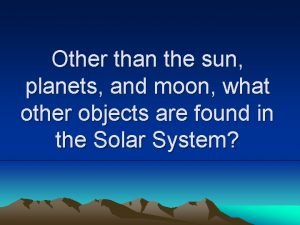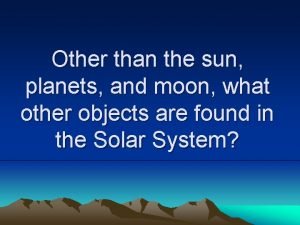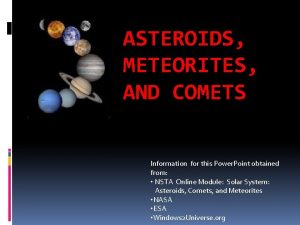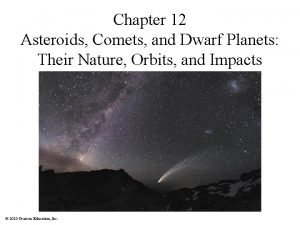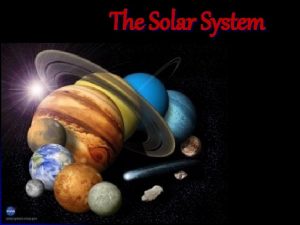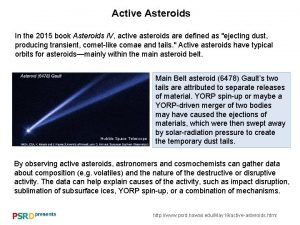COMPONENTS OF THE SOLAR SYSTEM Asteroids are huge




- Slides: 4

COMPONENTS OF THE SOLAR SYSTEM

Asteroids are huge boulders made mostly of iron and nickel. They come in all sizes. There is an asteroid belt between Mars and Jupiter. It is estimates that there are over a million asteroids larger than 1 km in diameter and many millions more of smaller sizes. Not all asteroids stay in the belt. Astronomers map and track as many as possible to avoid collisions with Earth. The chances of a collision are actually very small. ASTEROIDS

They are also known as shooting stars or falling stars. A meteoroid is a piece of rock. Floating around in space orbiting the sun. Usually it is no bigger than a grain of sand. There are billions and billions of meteoroids. Many meteoroids are actually pieces of rock and dust that melt off comets as they approach the sun. When a meteoroid enters the Earth’s atmosphere, it is then called a meteor. Most meteors vaporize and completely burn up several miles above ground. For example: RUB YOUR HANDS QUICKLY TOGETHER- FRICTION! LIKE A METEOR RUBBING AGAINST Earth’s atmosphere. Occasionally a large meteor will hit the ground or shatter above the ground. The shattered pieces are called meteorites. METEOROIDS, METEORS, AND METEORITES

Comets are essentially giant, dirty snowballs in space made of frozen gases with tiny pieces of rock and dust mixed in. Comets just stay in space orbiting the Sun until something happened to knock a comet out of its orbit. It then begins to fall toward the nearest object with the most gravity--- the sun. Some fall into the sun and are destroyed. Some fall toward the sun and fly away never to be seen again. others fall into a new orbit and reappear every so many years. Halley’s comet orbits the sun once every 76 years. It was last seen in 1986. when will it be seen again? 2062 As a comet approaches the sun, it heats up and begins to melt. As it melts, all the gas vapors and dust particles are blown away from the nucleus (head) by solar wind. This creates the tail. The tail of a comet always points away from the sun. so sometimes, it actually appears to be flying backward. COMETS

